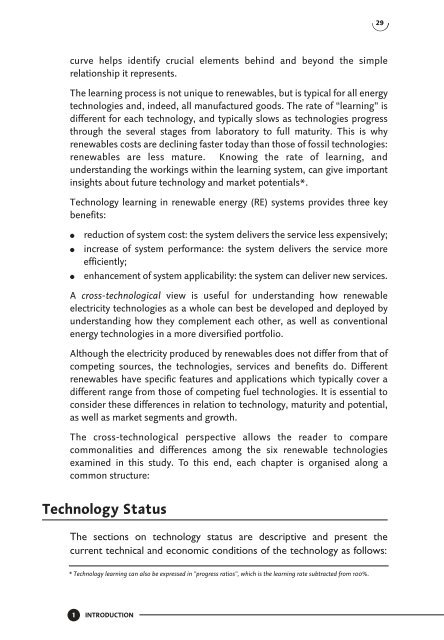Technology Status - NET Nowak Energie & Technologie AG
Technology Status - NET Nowak Energie & Technologie AG
Technology Status - NET Nowak Energie & Technologie AG
You also want an ePaper? Increase the reach of your titles
YUMPU automatically turns print PDFs into web optimized ePapers that Google loves.
curve helps identify crucial elements behind and beyond the simple<br />
relationship it represents.<br />
The learning process is not unique to renewables, but is typical for all energy<br />
technologies and, indeed, all manufactured goods. The rate of “learning” is<br />
different for each technology, and typically slows as technologies progress<br />
through the several stages from laboratory to full maturity. This is why<br />
renewables costs are declining faster today than those of fossil technologies:<br />
renewables are less mature. Knowing the rate of learning, and<br />
understanding the workings within the learning system, can give important<br />
insights about future technology and market potentials*.<br />
<strong>Technology</strong> learning in renewable energy (RE) systems provides three key<br />
benefits:<br />
● reduction of system cost: the system delivers the service less expensively;<br />
● increase of system performance: the system delivers the service more<br />
efficiently;<br />
● enhancement of system applicability: the system can deliver new services.<br />
A cross-technological view is useful for understanding how renewable<br />
electricity technologies as a whole can best be developed and deployed by<br />
understanding how they complement each other, as well as conventional<br />
energy technologies in a more diversified portfolio.<br />
Although the electricity produced by renewables does not differ from that of<br />
competing sources, the technologies, services and benefits do. Different<br />
renewables have specific features and applications which typically cover a<br />
different range from those of competing fuel technologies. It is essential to<br />
consider these differences in relation to technology, maturity and potential,<br />
as well as market segments and growth.<br />
The cross-technological perspective allows the reader to compare<br />
commonalities and differences among the six renewable technologies<br />
examined in this study. To this end, each chapter is organised along a<br />
common structure:<br />
<strong>Technology</strong> <strong>Status</strong><br />
The sections on technology status are descriptive and present the<br />
current technical and economic conditions of the technology as follows:<br />
* <strong>Technology</strong> learning can also be expressed in "progress ratios", which is the learning rate subtracted from 100%.<br />
1<br />
INTRODUCTION<br />
29







